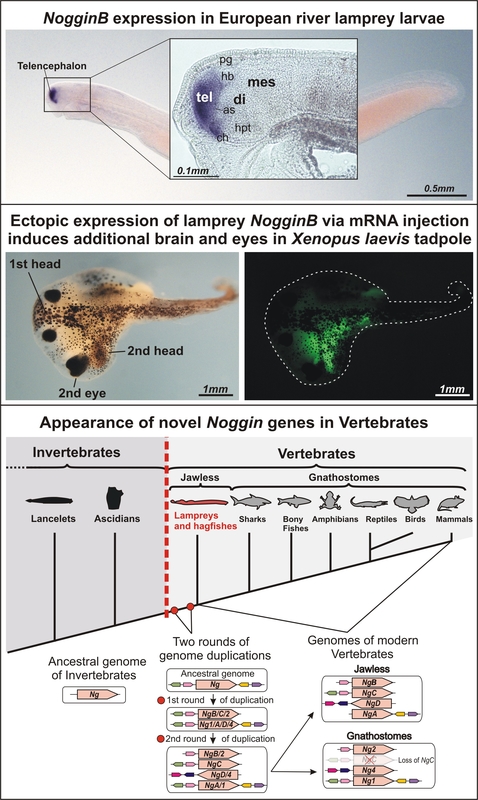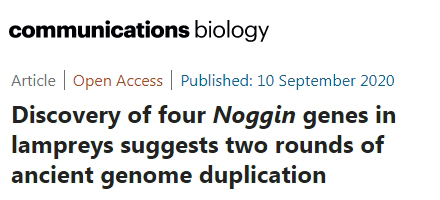Press-room / news / Science news /
The discovery of four genes of the Noggin family in lampreys is consistent with the hypothesis of two rounds of genomic duplications in vertebrate ancestors
Researchers from the Laboratory of Molecular Bases of Embryogenesis, together with a colleague from the Severtsov Institute of Ecology and Evolution, described for the first time four genes of the Noggin family in the oldest representatives of vertebrates - lampreys, and compared their structure, expression and some functional features with those of the known genes of this family in other vertebrates.
According to the contemporary point of view, the genetic basis for the emergence of vertebrates, including humans, were duplications of the ancestral genome of invertebrates. As a result of such duplications, additional copies of many regulatory genes have arisen. Once removed from the constraining pressure of natural selection, these new genes were able to relatively freely modify their structure and functions, and, as a consequence, change the individual development and final structure of organisms. As a result, vertebrates have developed many important anatomical and functional innovations that are lacking in all other animals. In particular, one of these innovations was the emergence of a new brain region, the telencephalon. Developing and improving in the evolution, this new part of the brain provided conditions for the emergence of highest forms of the nervous activity that humans have today.
Although the hypothesis of duplications of the ancestral genome at the early stages of vertebrate evolution was formulated for the first time in 1970, questions about the number of these duplications, their scale (genome-wide or local), and the particular time of appearance in evolution are still actively discussed. One of the ways to answer this question is to compare the genomes and mechanisms of the individual development of gnathostomates vertebrates (fish, amphibians, birds and mammals) with those of representatives of the most ancient group of modern vertebrates - jawless (lampreys and hagfishes). Since the separation of the branches of jawless and jawed took place at the earliest stages of vertebrate evolution, the genome structure and mechanisms of individual development in modern jawless species in many aspects considered to be a kind of "conserved" variant of the genome and developmental mechanisms characteristic for the first vertebrates. As such, comparing genomes and embryonic development in jawless and jawed can help reconstruct the evolutionary history and understand the mechanisms underlying anatomical and functional innovations in vertebrates.
The "living fossils", lampreys, considered to be a very suitable model for such studies. In this work, we performed a search and comparison with their homologues in vertebrates the lamprey genes of Noggin family. Earlier, we and other authors have described three genes of this family in jawed vertebrates, including humans. It was shown that secreted proteins encoded by Noggins regulate BMP, Activin / Nodal, and Wnt signaling and, as a consequence, many aspects of the individual development, including early development of the telencephalon.
In the present work, we have established for the first time that, in contrast to the jawed vertebrates, the lamprey genome contains four Noggin genes. We have studied the local genomic syntheny and phylogeny of these genes, as well as, patterns of their expression and the conservatism of some functional properties. It has been shown that the lamprey genes, which we named NogginA and NogginC, are orthologues of Noggin1 gene of the jawed vertebrates, while NogginB is the ortholog of Noggin2. Like the jawed Noggin2, the lamprey NogginB is actively expressed in the telencephalon rudiment from the earliest stages of its development, and in functional tests it demonstrates an increased ability to induce forebrain structures with eyes. The fourth lamprey gene, NogginD, showed many traits similar to Noggin4 of jawed, which, as we showed earlier, specifically regulates Wnt signaling.

Based on the data obtained and taking into account the fact that the genomes of the closest relatives of vertebrates, lancelets and ascidians, contain only one Noggin gene, we compared the possible scenarios for the evolution of genes of this family in vertebrates. As a result, it was concluded that the most likely scenario is one that presumes two rounds of genome-wide duplications of the ancestral invertebrate genome, which occurred in the Proterozoic era, about 550-520 million years ago, at the earliest stages of vertebrate evolution, i.e. e. even before their division into branches of jawless and jawed.
The work was supported by the Russian Foundation for Basic Research and Russian Science Foundation and published in the new journal of Nature Publishing Group - Communications Biology, IF 4.165, Q1
september 10, 2020




